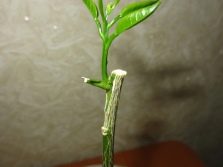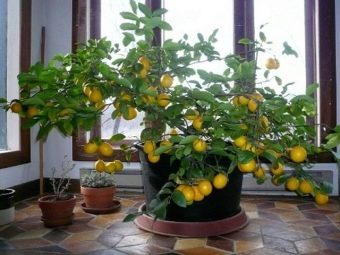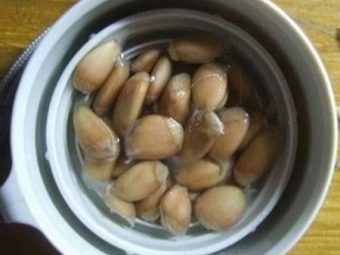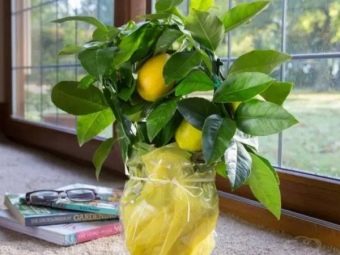How to grow a lemon from the stone at home?
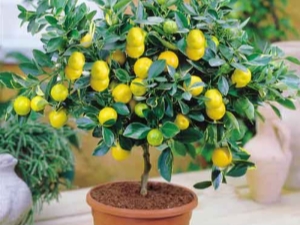
Tea for a Russian person is not only a way to quench your thirst, but also a good reason to gather at the table with your whole family and discuss family problems or plans, remember pleasant moments from a vacation or a trip. Lemon tea inspires a person and whole families to make new life discoveries and brings together soul mates. You can sprout the bone of that same lemon and grow a whole lemon tree on your windowsill, especially since it is not difficult.
Can I grow at home?
Lemon tree is not only possible, but also needs to be grown in room conditions. It is not only a large indoor plant with a rich green glossy leaves, but also a fruit bearing that will give its host healthy and fragrant fruits.
Such a plant in the house looks very presentable, it can decorate the interior, made in any style and color. Growing a lemon in an apartment is not only a decorative issue, but also an ecological one. Lemon tree has high absorbing properties, so it can save the room from excess moisture and odors. This plant perfectly processes carbon dioxide and turns it into fresh air, which can partly replace airing. A large number of essential oils contained in the leaves of lemon, will be an excellent repeller of insect pests, such as mosquitoes, flies, centipedes, bugs and even cockroaches.
Growing a lemon at home is pretty simple.
There are three known ways to grow lemons in a pot.
- Cuttings. This method is the most rapid start of flowering and fruiting of the lemon tree.
- Grafting. This method is mainly used by gardeners for further planting in the greenhouse. This method is the most time-consuming, because you need to be able to choose the graft process correctly and carry out the grafting procedure correctly. In addition, it is a huge stress for the trees, so it will take efforts to carry out proper rehabilitation.
- Seeds. Planting a lemon under the bones is a very simple way of breeding lemon, suitable even for people unknowing in the art of gardeners. A tree grown from a stone does not need special care, however, it starts to bear fruit rather late.
Despite the chosen method of planting a lemon, it grows about the same, leaving requires minimal, and the pleasure from the process will exceed all expectations.
Suitable varieties
Despite the fact that lemon is a deciduous plant, in nature it grows as evergreen. At home, a lemon tree will also delight the host with a riot of greenery throughout the year. However, it is not worth forgetting that this plant is wild, because wild plants are not able to survive in cramped apartment conditions. Thanks to the centuries-old experience of selection, today there are a number of unpretentious varieties that can not only take root in growing conditions in a pot, but also give an excellent aromatic harvest. In order to grow a beautiful, high-quality lemon tree, you should choose one of the following varieties.
- "Chinese Dwarf". In the circles of experienced gardeners, this variety is known as "Mayer". He bred by breeders by crossing the seed of orange and lemon. This plant is ideal for growing in cramped conditions apartments with small rooms and low ceilings, because its size does not exceed 70 centimeters. Fruiting plants of this variety once or twice a year. Up to 20 lemons can be harvested in each crop. The fruits of this variety are more rounded, their color is slightly darker than normal lemons, closer to the orange shade. The size of the fruit is slightly smaller than the size of ordinary lemons. The flesh of citrus is slightly sweeter than usual, the crust is thin with small pores. The aroma of lemons is bright, traditional. The fruits of this tree are considered dessert.However, it is worth remembering that this plant is a bit more whimsical than its relatives, therefore in the autumn and winter period it is important to arrange additional ultraviolet lighting and feeding with highly active vitamin complexes for citrus.
- "The hand of Buddha." This variety is often called "Corsican", because it is this island that is considered its homeland. A tree of this sort reaches a height of 1.5 meters, and sometimes more. At home, such a plant bears fruit year-round, but it is possible to collect no more than 10 lemons per year from it. The fruits of the “Buddha Hand” variety grow very large, bright yellow with a thick crust and a thick white layer. The flesh is coarse-grained, juicy, the membranes are hard. Taste and aroma of lemons of this variety are weakly expressed, most often such fruits are used to make candied fruits, sauces, as seasoning to other dishes. This variety is great for making fresh juice and lemonade, because it is very juicy and not too sour.
- "Pavlovsky." Bred by Russian breeders, taking into account the characteristics of the local climate. An adult tree reaches a height of 1.5 meters, fruiting lasts all year round. In one year you can collect up to 15 lemons. The tree begins to bear fruit about three years after planting or germination. This is the most unpretentious variety of lemon, it perfectly tolerates both excess and insufficient illumination, does not require frequent watering, and easily tolerates the autumn-winter period. For the health of such a tree, it is enough to feed vitamins once a year and transplants no more than once every two years. The fruits of this variety are not too large, with a thin, fine-pored skin of light yellow color. The flesh of the fruit is very juicy and very fragrant, ideal for making tea and fresh juices.
- "Maikop". This variety is excellent for germination in the southern regions of Russia. This is a particularly thermophilic variety, so a lemon tree of this kind can be safely carried out in the summer. Sunbathing, fresh air and rain watering have a beneficial effect on the condition of the tree. The plant begins to bear fruit on average three years after planting, but in the southern regions, where most of the year is sunny, the first crop can be obtained in a year and a half. The fruits of this variety are not too large, with a friable, light yellow skin and a sharp "nose". The flesh is dryish, but quite fragrant.
Will the plant bear fruit?
Anyone who decides to grow a lemon at home is unconsciously wondering whether a plant grown in an apartment will bear fruit. The answer to this question can not be unambiguous, but it will be more positive than negative. Fruiting almost always occurs, but in rare cases this may not happen.
As a rule, plants grown in improperly selected soil are incapable of flowering.
Most often, this plant stops developing, reaching a height of 40-50 centimeters. Such a plant can live in such a state from 2 to 6 years, it will be a pretty houseplant, but no more.
Under normal conditions, fruiting may occur 1–5 years after planting, depending on the variety and way of planting. To speed up the appearance of the first harvest is possible For this, a procedure was invented, known among gardeners under the name “ringing” or “banding”. The essence of the procedure is to redirect the flow of fluids and nutrients inside the tree. For this you need to wrap a piece of copper wire over the 2-3 branches on the trunk of the tree. The wire should gird the tree with one ring and slightly squeeze its bark, but not too stylish, so as not to damage the external and internal tissues of the plant. This will slightly slow down the flow of tree sap to the branches above the ring and, accordingly, will increase the flow of fluids and beneficial substances to the branches under the ring.This will lead to the first budding and flowering. After six months, the ring must be removed, because it will interfere with the healthy growth of the tree. The first banding can be carried out a year after planting a tree. You should not abuse this method, because after the first flowering the tree will continue to bloom on its own.
How to plant?
It is quite simple to grow a tree from a bone of a lemon, absolutely every person can handle it. You just need to remember a simple sequence of actions and a few helpful tips.
In order to be able to germinate a bone of lemon, you need to choose the right fruit: a lemon must be even, with a uniform color, without potholes and dents. All these signs indicate that the fetus is mature and intact, and therefore planting material is normal. The bones of the lemon must be whole and freshly removed from the fruit. It is better to choose a few seeds from different lemons in order to choose the strongest and strongest seedlings.
Selected seeds need to be folded in a small container and pour slightly warm water, leave them in this condition overnight. During this time, a large amount of oils and starch will be released from the bones, water may become similar to mucus. The bones will soften, the upper layer will peel off. This thin, transparent cover can be carefully removed - it makes germination difficult.
It is important not to damage the integrity of the inside of the seed, so you need to act very carefully. Untreated lemon bones can sprout more than six months, peeled - twice as fast.
Then the seeds can be put for an hour in a solution of sodium humate - it is an effective stimulator of the growth of fruit plants and will help speed up germination.
For the germination of seedlings need to use shallow pots, you can give preference to boxes, divided into sections. In the pot, it is important to organize the drainage holes. In addition, it is desirable to purchase a drainage mixture. Soil should be selected with the note "for citrus" or "for indoor plants". It is not necessary to acquire the soil intended for the cultivation of seedlings - for citrus plants in it is too high acidity. Ordinary land from the garden is also not very suitable for the germination of citrus. The soil can be fertilized with peat, but this is not necessary, because often ready-made mixtures are already fertilized. In prepared trays it is necessary to pour a layer of soil at about 1/3 of the height of the pot, then you need to pour the drainage mixture in a layer of 1-2 centimeters, and on top of it again the soil layer.
Lemon seed should not be buried deeper than 1.5 centimeters. The distance between them must be at least 5 centimeters in all directions. The seed pot should be wrapped in a plastic bag and left in a warm room until the first sprouts appear. Occasionally, you can slightly spray the soil, but you should not water it abundantly - the seeds can rot.
After the appearance of the first shoots they need to cover the banks. Pots with seedlings need to put in a well-lit place, for example, on the windowsill. During this period, proper care of the seedlings is very important: it must be slightly sprayed with water, jars should be removed for 1-2 hours a day so that the cuttings are hardened and then covered again. When the first leaves appear on the sprouts, they should be transplanted into small but separate pots. Planting in large pots is acceptable when the trees reach 15-20 centimeters in height.
Care
At first glance, a lemon tree is an unpretentious plant that does not require special care. In fact, the way it is, however, there are several factors that make this plant a real home tyrant. For example, this plant does not tolerate even the slightest movement around the room. Any relocation will lead to an indispensable stress, dropping foliage and a long, protracted recovery, so it is crucially important to choose the habitat of a lemon in the house once and for all.
This is what you should pay close attention to when choosing a place for a pot.
- Proper lighting. Lemon tree is very whimsical to the right combination of light and shade: it loves bright rooms, but you should avoid direct rays on the leaves. With too much light, citrus fruits start to grow too actively, while all the juices are wasted on growing branches. In such conditions, you can get a huge tree that will not begin to bear fruit. Lemons tolerate the partial shade, but the darkness does not like this tree. He needs enough light for active photosynthesis. The best place for a lemon tree in a house is a room with large windows facing east or west.
This is a very sun-loving plant, so the crown always reaches for the light. In order for a tree to have equally lush greenery from all sides, it must be periodically rotated around its axis, approximately 1/4 of a turn once every 1.5-2 weeks.
- The ideal temperature. Lemon tree whimsically and to temperature. The ideal option for him is the same temperature at any time of the year. So, for example, the lemon will feel great, if in the summer and in the winter time the daytime temperature will be 26 degrees, and the nighttime temperature will be 20 degrees. However, in the Russian climate, it is sometimes impossible. To create more comfortable conditions for the tree, it is necessary to choose a place away from the radiators, which can cause overheating. It is also worth avoiding places with drafts. It is undesirable to place a lemon near or opposite the entrance door, so as not to catch a cold.
It is important to remember that moving a lemon during its flowering is unacceptable - this will inevitably lead to dropping of flowers and destruction of the harvest.
In addition to the choice of location for the location of the pot, it is worth remembering a few important factors that may affect the well-being of the lemon tree.
Watering
The lemon root system does not like watering too much. To create a more comfortable environment, you can fill the pot with gravel, put a pot on top and periodically pour water into the pan. From the gravel moisture will seep into the soil through the drainage holes in the pot. This will minimize wetting of the root system of the plant. On hot summer days, two not too much irrigation per week is enough for a lemon; in the winter period, it can be limited to one watering per week. At the same time, leaves and branches of lemon love moisture, so it is very important to organize frequent spraying of greenery from the sprayer. This procedure should be carried out as often as possible, whenever possible daily. But do not be too zealous with spraying - streams should not flow from the leaves; rather, it should resemble abundant dew.
Regular transplanting
It is very important to transplant the lemon tree in a timely manner, since it is very depleting the soil. In the early stages, transplantation should be done once a year in the spring. Further, it will be optimal to repot the tree once every two years.
It is necessary to replant a tree only in a specialized soil, since it is most saturated with useful substances, which will allow the tree to live between the changes in comfortable conditions.
In the process of transplanting it is important to properly care for the root system of the tree. It needs to be trimmed so that it can be updated over the next two years before transplanting. If the root system is not updated in this way, premature aging of the tree will occur, which will lead to its imminent death.
Top dressing
A high-quality and timely top dressing plays a very important role in maintaining the well-being of the lemon tree. In the garden centers, you can easily choose high-quality vitamin preparations for citrus.
The main rule of lemon fertilizer is to feed the tree in a timely manner.
In the summer, the need and effectiveness of complementary foods increases, so you should do vaccinations with liquid vitamins once a week. In the remaining months, the number of supplements should be reduced to once a month.
There are a number of folk remedies that can be a worthy replacement for store-bought drugs: an infusion of nettle, an infusion of an egg shell or a weak solution of cow or bird droppings.
Cropping
Pruning a house tree is a very important issue, because not every home will fit a full-sized tree with a large spreading crown.
In addition, the following fact has long been recognized: the more magnificent the citrus crown, the smaller the yield they will give.
In this regard, you should not allow the tree to grow too lush crown. It is necessary to cut the lemon tree with care, adhering to the correct proportions and periodicity - this will allow not harming the tree, but, on the contrary, improve its condition. The first pinching is carried out when the sprout of the future tree has reached a height of 20 centimeters, each subsequent - every 20 centimeters of plant growth.
For the formation of the crown of the correct form, you need to pinch and branches. It is necessary to begin to form the crown from the first tier of the branches; each subsequent tier should be shorter than the previous one by several centimeters.
Diseases and pests
It is not too difficult to germinate a lemon from a stone, but not all trees are able to survive to the first fruits. Potted lemons are very painful, they have almost no immunity to any known plant diseases. It is very important to follow all the above rules of care for the lemon tree, so as not to create an environment conducive to the development of disease.
Most insects and pests avoid contact with the lemon tree due to the large amount of essential oils in its leaves, however there are a number of parasites that are even attracted to oils. Citrus fruits are most often attacked by aphids, spider mites and scutes. As a rule, the first symptom of the pest attack is the appearance of a small spider web on the plant, later light spots appear on the leaves and the trunk, then the leaves begin to curl and dry. To cure the plant from parasites, you can use special anti-parasitic drugs that can be easily found in garden centers or flower shops. The most effective drugs are "Aktara" and "Clean List". They are respected by experienced gardeners and have positive customer reviews.
Pest problems are easy to avoid. To do this, you need simple measures: in the hot season, the plant needs to hold a shower once a week. To do this, pollinate the leaves with water at room temperature from the sprayer. In the cool season you need to spray the leaves with lightly warm water once a month.
One of the most common problems associated with growing indoor lemons is yellowing and falling leaves. As a rule, this is not a symptom of the disease, but rather a sign of improper care of the plant.
Most often the leaves turn yellow for such reasons:
- temperature of the plant is too high (over 28-32 degrees);
- too much draft at the location of the pot;
- insufficient or excessive watering;
- watering the plant with too cold water;
- soil depletion, delayed transplantation time;
- poor plant lighting;
- soil acidity too high.
In order to remedy the situation, it is enough to identify and eliminate the cause: rearrange the plant to another location, change the irrigation mode or transplant it into a new soil.
There are a number of diseases characteristic of home grown citrus trees. Often, the success of treatment depends on the identification of the disease in the early stages of its development.Among the most common diseases of citrus there are several incurable, which can destroy the plant in a few weeks.
Chlorosis
The peculiarity of this disease lies in the fact that the plant almost completely stops the production of chlorophyll, in connection with this stops the process of photosynthesis. At the initial stages of the development of the disease, the leaves of the plant begin to brighten and gradually lose their color, then they become thinner and fall off. On the dark green glossy sheets of lemon is difficult not to notice the signs of this disease, they become visible immediately after infection of the plant. Chlorosis can be infectious or hereditary, it affects only young plants. In the case of trees, lemons are only sprouts that are less than a year old. Timely feeding, tracking and preventing pest problems will help to avoid infection with this disease. In the case of infection, micronutrients can be injected into the trunks, branches and roots of a diseased plant, but this method of treatment does not always help - it all depends on the plant’s own immunity.
Root rot
Most often, root rot develops due to excessive watering of the plant during the cold season. Constantly wet soil leads to the fact that the root of the plant begins to rot. Outwardly, this disease is difficult to detect. A clear sign of root rot of lemon can be considered leaf fall. If the leaves of lemon fall for no apparent reason, you need to remove the plant from the pot, carefully shake off the soil from its roots, trying to cause her as little damage as possible. The affected parts of the rhizome need to be cut, and the plant with a healthy root should be transplanted into a new, dry soil. Further, watering should be minimized, and in order to compensate for the lack of water, you should regularly wipe the leaves of the plant with a clean, wet washcloth.
Late blight
Known in the territory of Russia fungal disease. The treatment regimen of late blight citrus is exactly the same as that of any garden plant. Diseased areas need to be treated with copper sulfate. For complete healing of the plant, antibiotic treatment is necessary. After curing late blight, unfavorable conditions must be created for the development of fungal infections: rare and not too abundant watering, and a dry, well-ventilated room will help avoid relapse.
Gommoz
It is an infection of the root and the trunk of the tree. The first signs of the disease are cracks at the base of the tree trunk. After some time, a dark liquid begins to seep through the cracks, then the tree fades, and it becomes impossible to save it. When the first signs of the disease are detected, you must immediately dig up the plant, remove all affected roots and cut off the affected bark, treat all exposed areas with copper sulphate or highly concentrated manganese solution and transplant the tree into a new pot with fresh soil.
Tristeza
This is an incurable viral infection. On the territory of Russia is quite rare, so infection with it is almost impossible. However, if for unexplained reasons, the home lemon began to flake off and fall off the bark, it is better to immediately get rid of this plant, because tristeza is a very contagious disease that quickly spreads to all houseplants.
Leaf mosaic
This is an infection that is not treatable. However, with the timely detection of the problem, you can stop its development, thereby saving the tree from destruction. The first signs of leaf mosaic disease are the appearance of a characteristic “marble” pattern on the leaves. In the event of further development of the disease, these spots begin to grow along with the tissues of the leaves, the leaves bend and curl. Further, the disease spreads to the branches and trunk. Affected tissue also swells and causes a trunk to crack. At this stage it is impossible to save the plant. When detecting the first symptoms of the disease, it is important to remove all affected leaves.You can even act radically - remove the entire diseased branch. All cuts need to be treated with a weak solution of manganese; a healthy part of the tree is preferably pollinated with the same solution from the sprayer. It is advisable to isolate the infected plant from healthy flowers for 1-2 months.
Citrus Cancer
This is a bacterial disease that develops when a saprophytic microbe enters a healthy plant. Surprisingly, only plants that grow outside their historic homeland are susceptible to this disease. Plants of China and India have never suffered from this disease. Absolutely all parts of the tree are exposed to this disease: from the root to the fruit. Light watery spots appear on the infected surfaces of the tree, which gradually darken and turn into necrotic foci. A favorable environment for citrus cancer bacteria is too wet soil with a high average daily temperature.
Bacteria that cause cancer have a remarkable feature - they fluoresce in the dark. If the plant suddenly began to glow at night - this is the first sign of citrus cancer. Unfortunately, this disease does not respond to treatment, and when confronted with it, it is important to save other plants — to do this, destroy the sick and treat all the tools and surfaces around the infection site with disinfectants.
How to grow a lemon from the seed, see the following video




